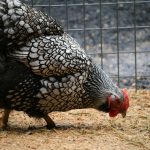One common issue faced by chicken owners is the presence of pine shavings in the chickens’ water supply. This occurs when chickens scratch and kick bedding material into their waterer, contaminating the water. Contaminated water is not only unappealing for chickens to drink but can also pose health risks if shavings are ingested.
Furthermore, shavings in the water can clog the waterer, impeding access to clean water. Understanding the causes and consequences of this problem is essential for developing effective preventive measures. The presence of pine shavings in chicken water often results from natural chicken behavior.
Chickens instinctively scratch and kick at their bedding to create comfortable nesting areas, which can inadvertently lead to shavings entering the waterer, especially if it is placed too close to the bedding. Environmental factors such as wind or rain can also contribute to shavings being blown or tracked into the water supply. Chicken owners should be aware of these factors and take proactive steps to prevent water contamination.
By identifying the root causes of this issue, owners can implement strategies to minimize shavings in the waterer and maintain a clean, healthy water supply for their flock.
Table of Contents
- 1 Choosing the Right Watering System for Your Chickens
- 2 Properly Positioning the Waterer to Minimize Contamination
- 3 Using a Barrier to Keep Pine Shavings Out of the Water
- 4 Regular Maintenance and Cleaning of the Waterer
- 5 Training Chickens to Avoid Scratching and Kicking Shavings into the Water
- 6 Alternative Bedding Options to Minimize Contamination
- 7 FAQs
Key Takeaways
- Pine shavings in chicken water can lead to contamination and health issues for the chickens.
- Choose a watering system that minimizes the risk of pine shavings getting into the water.
- Properly position the waterer to prevent contamination from surrounding bedding and debris.
- Use a barrier around the waterer to keep pine shavings out of the water.
- Regularly clean and maintain the waterer to ensure the water stays clean and safe for the chickens.
Choosing the Right Watering System for Your Chickens
Types of Watering Systems
The most common types of watering systems for chickens include gravity-fed waterers, nipple waterers, and automatic waterers. Gravity-fed waterers are simple and inexpensive, relying on gravity to dispense water into a dish or trough for the chickens to drink from. Nipple waterers are designed with small valves that release water when pecked at by the chickens, keeping the water clean and reducing the risk of contamination. Automatic waterers are connected to a water source and refill automatically as the chickens drink, providing a constant supply of clean water.
Factors to Consider
When choosing the right watering system for your chickens, it is important to consider factors such as the size of your flock, your budget, and the level of convenience and cleanliness you desire. The specific needs of your flock and the level of maintenance you are willing to commit to should also be taken into account.
Choosing the Right Watering System
Gravity-fed waterers are a popular choice for small flocks or backyard chicken owners due to their simplicity and affordability. However, they are more prone to contamination from shavings and debris, requiring frequent cleaning and maintenance. Nipple waterers are a more hygienic option, as they keep the water clean and free from contamination, but they may require more initial investment and installation. Automatic waterers are ideal for larger flocks or commercial operations, providing a continuous supply of clean water with minimal effort. By selecting a suitable watering system, chicken owners can minimize the risk of contamination from pine shavings and ensure a consistent supply of clean water for their flock.
Properly Positioning the Waterer to Minimize Contamination
Proper positioning of the waterer is crucial in minimizing contamination from pine shavings and other debris. Placing the waterer at an appropriate height and distance from the chicken bedding can help prevent shavings from being kicked or scratched into the water supply. Additionally, positioning the waterer in a sheltered area or using protective covers can help shield it from environmental factors such as wind or rain that may contribute to contamination.
By strategically placing the waterer in the chicken coop or run, chicken owners can reduce the risk of shavings getting into the water supply and ensure a clean and accessible source of hydration for their flock. When positioning the waterer, it is important to consider the natural behavior of chickens and how they interact with their environment. Chickens are known to scratch and kick at their bedding, so it is essential to place the waterer at a height that is easily accessible for drinking but out of reach for scratching.
This can be achieved by using elevated stands or hanging mechanisms to keep the waterer off the ground and away from the bedding. Additionally, placing the waterer in a sheltered area or using protective covers can help prevent contamination from environmental factors such as wind or rain. By taking these factors into consideration and properly positioning the waterer, chicken owners can minimize the risk of pine shavings getting into the water supply and ensure a clean and healthy source of hydration for their flock.
Using a Barrier to Keep Pine Shavings Out of the Water
One effective strategy for preventing pine shavings from contaminating the chicken water is to use a barrier around the waterer. This can be achieved by creating a designated area around the waterer that is free from bedding or using physical barriers such as fencing or covers to prevent shavings from being kicked or blown into the water supply. By creating a clear separation between the waterer and the bedding, chicken owners can minimize the risk of contamination and ensure a clean and accessible source of hydration for their flock.
Creating a designated area around the waterer that is free from bedding can help prevent shavings from being kicked or tracked into the water supply. This can be achieved by using materials such as gravel or concrete to create a clear space around the waterer where chickens can access clean water without coming into contact with shavings. Additionally, using physical barriers such as fencing or covers can help shield the waterer from environmental factors such as wind or rain that may contribute to contamination.
By implementing these strategies and using barriers to keep pine shavings out of the water, chicken owners can maintain a clean and healthy water supply for their flock.
Regular Maintenance and Cleaning of the Waterer
Regular maintenance and cleaning of the waterer are essential in preventing contamination from pine shavings and ensuring a clean and healthy water supply for chickens. This includes regularly checking and refilling the waterer, as well as cleaning and sanitizing it to remove any debris or bacteria that may have accumulated. By establishing a routine for maintenance and cleaning, chicken owners can minimize the risk of contamination and provide their flock with a consistent supply of clean water.
Regularly checking and refilling the waterer is important in ensuring that chickens have access to an adequate supply of clean water at all times. This involves monitoring the water level and quality daily, especially during hot weather when chickens may drink more frequently. Additionally, cleaning and sanitizing the waterer on a regular basis is crucial in preventing contamination from pine shavings and other debris.
This can be done by emptying and scrubbing the waterer with a mild detergent or vinegar solution, rinsing thoroughly, and refilling with fresh water. By establishing a routine for maintenance and cleaning, chicken owners can ensure that their flock has access to a clean and healthy source of hydration.
Training Chickens to Avoid Scratching and Kicking Shavings into the Water

Redirecting Natural Behavior
Providing alternative areas for scratching and dust bathing away from the waterer can help redirect natural chicken behavior and minimize the risk of contamination. This can be achieved by creating designated areas with loose soil or sand where chickens can engage in scratching and dust bathing without coming into contact with the water supply.
Using Deterrents
Using deterrents such as physical barriers or repellent sprays can help discourage chickens from approaching or interacting with the waterer in a way that may lead to contamination. By implementing these deterrents, chicken owners can minimize the risk of contamination from pine shavings and maintain a clean and healthy water supply for their flock.
Ensuring a Clean Water Supply
By training chickens to avoid scratching and kicking shavings into the water supply, chicken owners can ensure a clean and accessible source of hydration for their flock. This is essential for maintaining the health and well-being of the chickens, and can be achieved through a combination of providing alternative areas for scratching and dust bathing, and using deterrents to discourage unwanted behavior.
Alternative Bedding Options to Minimize Contamination
In addition to implementing strategies to prevent pine shavings from contaminating the chicken water, considering alternative bedding options can also help minimize contamination and maintain a clean environment for chickens. Materials such as straw, hay, or sand can be used as bedding alternatives that are less likely to be kicked or tracked into the water supply by chickens. By choosing suitable bedding materials and maintaining a clean coop environment, chicken owners can reduce the risk of contamination and provide their flock with a healthy living space.
Straw, hay, or sand are alternative bedding options that are less likely to be kicked or tracked into the water supply by chickens compared to pine shavings. These materials provide comfortable nesting areas for chickens while minimizing the risk of contamination in their living environment. Additionally, maintaining a clean coop environment by regularly removing soiled bedding and debris can further reduce the risk of contamination from bedding materials.
By considering alternative bedding options and prioritizing cleanliness in the coop environment, chicken owners can minimize contamination from pine shavings and provide their flock with a healthy living space. In conclusion, preventing pine shavings from contaminating the chicken water requires an understanding of the problem, careful selection of watering systems, proper positioning of the waterer, use of barriers, regular maintenance and cleaning, training chickens’ behavior, and considering alternative bedding options. By implementing these strategies, chicken owners can minimize contamination from pine shavings and ensure a clean and healthy source of hydration for their flock.
If you’re struggling with keeping pine shavings out of your chickens’ water, you may want to check out this article on how to build an A-frame chicken coop. This resource provides tips on creating a clean and efficient coop setup that can help prevent bedding materials from contaminating the water source.
FAQs
What are pine shavings and why are they used in chicken coops?
Pine shavings are a common bedding material used in chicken coops. They provide a soft and absorbent surface for the chickens to walk and rest on, and also help to control odors and moisture in the coop.
Why do pine shavings end up in the chickens’ water?
Pine shavings can end up in the chickens’ water due to the chickens scratching and pecking at the bedding material, causing it to get kicked up and potentially land in the waterer.
What are the potential risks of pine shavings in the chickens’ water?
If pine shavings end up in the chickens’ water, it can lead to contamination and make the water unsuitable for drinking. Additionally, the shavings can clog the waterer, leading to a lack of access to clean water for the chickens.
How can I prevent pine shavings from getting into the chickens’ water?
To prevent pine shavings from getting into the chickens’ water, consider using a different type of bedding material, such as straw or sand, that is less likely to be kicked up by the chickens. Additionally, placing the waterer on a raised platform or using a cover can help keep the shavings out. Regular cleaning and maintenance of the coop can also help prevent shavings from accumulating in the waterer.
Meet Walter, the feathered-friend fanatic of Florida! Nestled in the sunshine state, Walter struts through life with his feathered companions, clucking his way to happiness. With a coop that’s fancier than a five-star hotel, he’s the Don Juan of the chicken world. When he’s not teaching his hens to do the cha-cha, you’ll find him in a heated debate with his prized rooster, Sir Clucks-a-Lot. Walter’s poultry passion is no yolk; he’s the sunny-side-up guy you never knew you needed in your flock of friends!







